Unpacking and publishing the Phaistos Disk since 1993
HOME | PREVIOUS | NEXT | SITEMAP
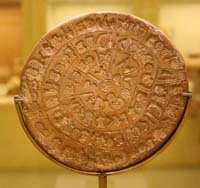
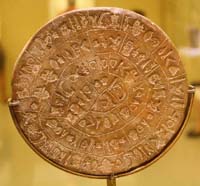
The Phaistos Disk is a small round object nearly 4,000 years old, a little larger than a CD, but is like a CD in terms of how much information it holds in such a small space. The Phaistos Disk is a university unto itself originating from the ancient world of Minoan Crete, an island in the middle of the Aegean Sea. Offering classes in geometry, mathematics, archaeology, astronomy, astrology, pictographs, creative design, and the antique science of "containment of geometrical arrangements," the Phaistos Disk is an entire ancient world-view perserved on a tiny disk. The world it describes is so old that the Greek poet Homer in 700 BCE called it ancient and forgotten. The Phaistos Disk is something like a message in a bottle but excavated over 100 years ago beneath the ruins of a palace instead of washed up on a beach.
Excavated 1908 in Phaistos, Crete, the Phaistos Disk is dated about 1,700 BCE. Mathematics is apparent on the disk, and we can discover Minoan concepts of mathematical relationships on this disk just by counting the pictographs and the spirals.
The artifact is terracotta pottery, about 6-1/4" diameter with 2 inscribed sides and 2 spirals per side, each spiral with 5 rings (10). The spirals are divided into 60 line segments (30 side A, 30 side B). The outside spirals have 12 line segments (24 outside); inside spirals have 18 (36 inside). Divided among the line segments and covering the disk are 240 pictograph impressions made with 48 unique miniature pictographs, 37 of which are variously repeated and appear identical, for a total of 229. 11 are unrepeated, bringing the total to 240.
The disk was found in 1908 at Phaistos, Crete, beneath the palace in a basement corner accessible by a trap door above. Beside it was a tablet of Linear A (undeciphered) writing of ancient Crete. The palace had been burned to the ground by an intense fire, perhaps explaining how the disk came to be fired in a civilization of baked pottery.
The disk delivers complex information in a simple and very playful way. Based on the Minoan love of mazes and the ancient method of forming constellations by connecting stars with lines, the disk - an artifact of astronomy - conceals the constellation Argo and other related images that are revealed when matching pictographs are connected by lines. This makes the Phaistos Disk a type of advanced maze puzzle, the solution of which not only reveals the solution to the maze but also provides a brilliant insight into that ancient civilization.
It is incredible to me that, for over 100 years, no one has thought to reveal these hidden geometric images. But the funny thing is, if this disk had been presented to us in the Sunday paper connect-the-dots section, we would have found a lot of the images before breakfast was over. This is because of the power that expectation plays in thinking and even in what our eyes see. Archaeologists never expected a connect-the-dots maze puzzle so they never saw it, and the linguists hard at work deciphering the pictographs just flat don't want to see it. Their expectations are for the personal discovery of a hieroglyphic script, like Egyptian hieroglyphs, and they are holding fast to that.
Concealed on the disk and revealed by connecting matching pictographs with lines are 8 major geometrical images and numerous additional geometries. These larger pictographs seem to tell an interesting story about navigating by the stars to the Great Pyramid, climbing all over it and going down inside it, as well as describing how geometry and the right triangle were used to build it.
As strange as it might seem to us that the Minoan astronomers would be discussing this, it is really not that far-fetched. Anyone in any period of time who studied the stars would observe the movement of the stars as a group and would certainly theorize about how the stars are fixed but also are in motion, and how the constellations transit the heavens as though on parade.
Below, the effects of spin on diameter are demonstrated by the Phaistos Disk in motion. The clockwise spinning spiral appears to spin counterclockwise so that diameter becomes a cross within a circle.
Diameter, Phaistos Disk spinning and a symbol from Minoan art that seems to imply spin
There was during that time a wide-spread number philosophy in the Bronze Age involving containment of geometrical arrangements, and this certainly must have seemed to have application in astronomy. Ancient astronomers might have concluded the movement of the stars to be some kind of illusion created by spin. If they did not actually conclude this, then certainly it could have crossed their minds and even been something they discussed. Obviously, they were brilliant astronomers. I admit to the possibility of giving them credit for more than is their due, but for the last twenty-two years I have been in awe of these people. And they have educated me because of this disk university left behind for posterity.
 To begin the solution to the maze puzzle, take a clue from this disk pictograph, left. A man, seemingly a warrior, is holding a shield containing tiny circles in the shape of a hexagram. This is a form of miniaturization of the entire disk, as a shield is two-sided as is the disk and the dots can be visually connected to reveal the hexagram. The puzzle is not so simple on the disk itself because the dots or pictographs on the disk are in a crowd of pictographs or dots and this complicates the puzzle. The dots inside the shield suggest a connect-the-dots approach of
viewing the disk. This is the profitable approach, as it reveals in total eight significant and complex images as well as numerous simple geometries that are concealed on the disk. The geometries, though "simple," are not random, as all forms of Euclidean geometry are represented on the disk 1,500 years before Euclid proclaimed them.
To begin the solution to the maze puzzle, take a clue from this disk pictograph, left. A man, seemingly a warrior, is holding a shield containing tiny circles in the shape of a hexagram. This is a form of miniaturization of the entire disk, as a shield is two-sided as is the disk and the dots can be visually connected to reveal the hexagram. The puzzle is not so simple on the disk itself because the dots or pictographs on the disk are in a crowd of pictographs or dots and this complicates the puzzle. The dots inside the shield suggest a connect-the-dots approach of
viewing the disk. This is the profitable approach, as it reveals in total eight significant and complex images as well as numerous simple geometries that are concealed on the disk. The geometries, though "simple," are not random, as all forms of Euclidean geometry are represented on the disk 1,500 years before Euclid proclaimed them.
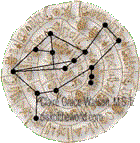
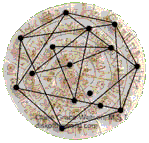
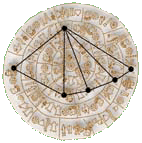
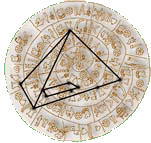

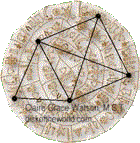
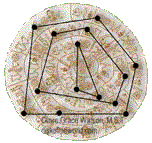
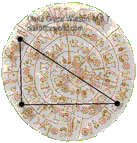
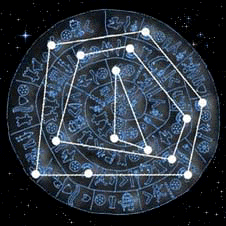
![]() Early astronomy, involving the study of the properties of a circle and the geometry of a sphere, comes under the antique study of "containment of geometrical arrangements." In this animation (my software animation of the Phaistos Disk, Warrior pictographs connected with lines) we see the effects of spin on geometrical arrangements that have been overlaid onto a spiral that is contained within a sphere. Spinning clockwise, the inside triangle appears to spin counterclockwise.
Early astronomy, involving the study of the properties of a circle and the geometry of a sphere, comes under the antique study of "containment of geometrical arrangements." In this animation (my software animation of the Phaistos Disk, Warrior pictographs connected with lines) we see the effects of spin on geometrical arrangements that have been overlaid onto a spiral that is contained within a sphere. Spinning clockwise, the inside triangle appears to spin counterclockwise.
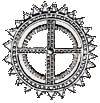

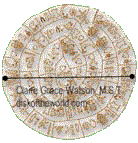

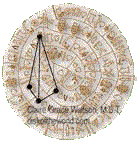
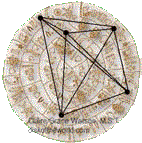
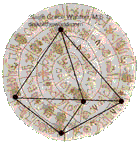
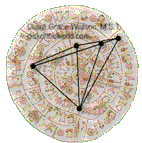
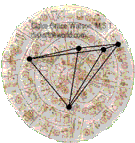
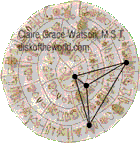

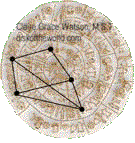
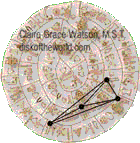

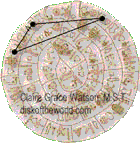
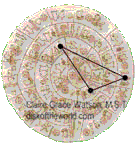

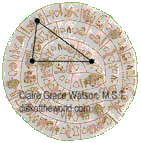




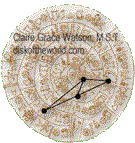
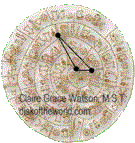
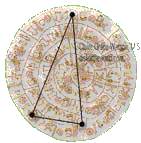
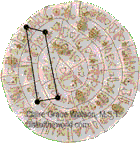
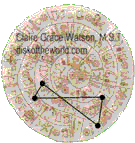


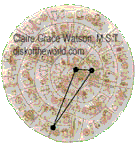
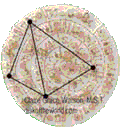
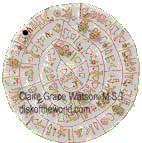
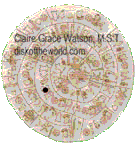

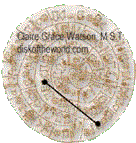


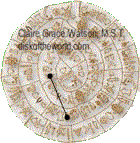

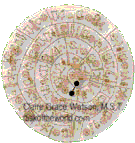
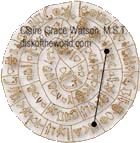
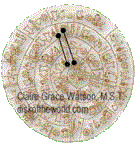
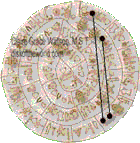
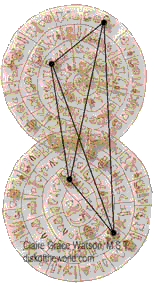
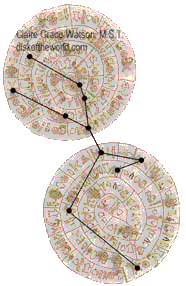


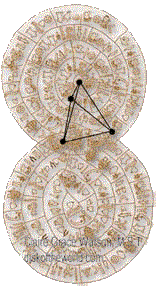
 The number One The Point within the Circle |
 The number Two Diameter The Cross within the Circle |
 The number Three Triangle The Hearth of the Universe |
 The number Four The Square within the Circle |


The number Five Pentagon, pentagram |


The number Six Hexagon, hexagram |


 The number Seven Heptagon, heptagram |


 The number Eight Octagon, octagrams |




The number Nine Enneagon, enneagrams |


 The number Ten Dekagon, dekagrams |


 The number Eleven Endekagon, endekagrams |




The number Twelve Dodekagon, dodekagrams |
 Every culture has its idea of God and of how the world was made. The idea of "God the Geometer" (left, 1220 ce, Bible Moralise of Blanche of Castile) is attributed to a much later age than Minoan Crete. But perhaps Crete was instrumental in making the Western world's religious transition from the ancient Egyptian idea of "God the Potter" to "God the Geometer." God the Potter is an old idea of creation that lingers, still.
Every culture has its idea of God and of how the world was made. The idea of "God the Geometer" (left, 1220 ce, Bible Moralise of Blanche of Castile) is attributed to a much later age than Minoan Crete. But perhaps Crete was instrumental in making the Western world's religious transition from the ancient Egyptian idea of "God the Potter" to "God the Geometer." God the Potter is an old idea of creation that lingers, still.
Dizzy on the Potter's wheel
I reel -- Under the pressure of His hand.
Water splashes over me; I choke and gasp for air.
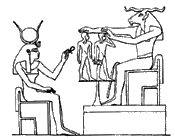 He cuts off softened chunks,
He cuts off softened chunks,
Refines the shape -- Remolds the inner core.
He whistles softly as He works.
I listen ... to the soothing sound
and slowly learn ... Relax and wait
For the Sovereign shape imaged in His mind.
(Jamie Seltzer)
For thousands of years the Egyptians envisioned the idea of God the Potter in their worship of the god Khnum, who created all of humanity on his potter's wheel. (above, right, with the help of Isis wearing the Winged Disk) In this respect the Phaistos Disk creater is following in the path of the god Khnum in the creation of the Phaistos Disk on a potter's wheel. Maybe the potter had the idea that not only humanity but the Universe is created on the potter's wheel, and the spinning of the wheel would explain the apparent counterclockwise circumnavigation of the stars.



 The image below seems to confirm this theory. The disk/shield demonstrates the Number Six Hexagon. (left) and the pentagram/star inside the heptagram accounts for Numbers 5 and 7, revealed by connecting the fifteen disk/shields on side one. (below)
The image below seems to confirm this theory. The disk/shield demonstrates the Number Six Hexagon. (left) and the pentagram/star inside the heptagram accounts for Numbers 5 and 7, revealed by connecting the fifteen disk/shields on side one. (below)

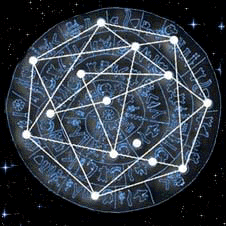 The pent/hept geometry, when set in motion, shows this illusion of counterclockwise movement of the geometry, and thus perhaps the stars, when overlaid onto a spiral contained within a sphere. When the disk is spun 360 degrees clockwise, the star and seven planets appear to travel counterclockwise.
The pent/hept geometry, when set in motion, shows this illusion of counterclockwise movement of the geometry, and thus perhaps the stars, when overlaid onto a spiral contained within a sphere. When the disk is spun 360 degrees clockwise, the star and seven planets appear to travel counterclockwise.
 This containment of geometrical arrangements is a combination of the Number Five Pentagram set inside the Number Seven Heptagram, the solution to excavating it suggested by the Number Six Hexagon on the warrior's shield (left) - just connect the dots (pictographs). The numbers 5, 6, and 7 are accounted for in this arrangement, and from this arrangement some religious philosophy, based on science, probably was conceived. (right and see table above).
This containment of geometrical arrangements is a combination of the Number Five Pentagram set inside the Number Seven Heptagram, the solution to excavating it suggested by the Number Six Hexagon on the warrior's shield (left) - just connect the dots (pictographs). The numbers 5, 6, and 7 are accounted for in this arrangement, and from this arrangement some religious philosophy, based on science, probably was conceived. (right and see table above).

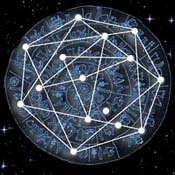

These geometries on the Phaistos Disk are behaving strangely and counter to what is expected, but this is because they are overlaid onto a clockwise spinning spiral that is contained within a sphere and instructed to spin. The Phaistos Disk creator(s), and others involved in this geometry theology, might have deduced their geometry theology from observation of the stars above, and then preserved it as the Phaistos Disk or "miniature world disk," that Khnum not only creates humans from clay on a potter's wheel but also creates a vast universe by using geometry, spirals, spheres and spin.
The delineation of constellations on a dark night was perhaps humanity's first attempt to make sense of the chaos of stars in motion and even to understand the universe in terms of geometry. In our evolution of consciousness, we discovered geometry to be a "divine" tool that lets us get a handle on the chaos above as we observe it from below and make sense of things. We perhaps also concluded that geometry was the gift of the goddess, a kind of GPS that lets us navigate around in a vast, confusing world.
We still ask this question, but in a different language and without thought of Khnum-Ra as That Which Contains. Simplistic ideas of the universe assert the existence of a large entity -- God -- as larger than the universe and wrapped around it somehow. It is simple to see how these things were considered religion by the Minoans who studied them. We still think it's religion even though modern Science has divorced Mysticism and left it destitute and homeless and even despised unless it can dress up like Science and be bombardable as a subatomic particle.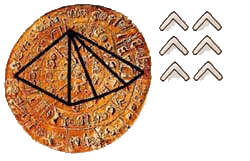 Standing on this pyramid of knowledge provided by the Phaistos Disk, we can see that the Milky Way (above right) behaves like the Phaistos Disk, and the application of containment of geometrical arrangements might apply. If the Earth is spinning counterclockwise on its axis while contained by a clockwise spiraling galaxy in which the stars and the sun seem to be revolving counterclockwise, then may we not deduce the galaxy is contained by a sphere that is the universe - a Disk of the World? And so, what is it or who is it that contains the sphere?
Standing on this pyramid of knowledge provided by the Phaistos Disk, we can see that the Milky Way (above right) behaves like the Phaistos Disk, and the application of containment of geometrical arrangements might apply. If the Earth is spinning counterclockwise on its axis while contained by a clockwise spiraling galaxy in which the stars and the sun seem to be revolving counterclockwise, then may we not deduce the galaxy is contained by a sphere that is the universe - a Disk of the World? And so, what is it or who is it that contains the sphere?
The Phaistos Disk is perhaps the first attempt on the part of humanity to create a miniaturization of the mechanical universe, to demonstrate the idea that understanding of the macrocosm of the universe can be extrapolated from the small model or microcosm of the universe. In this case, the theory would be "as below, so above." It is not a bad idea either to try to figure out the universe by these methods, lacking modern equipment and the Hubble telescope, since it only makes sense to use the materials at hand, along with our creativity, to make deductions and conclusions about how the larger world is operating. Newton used apples to prove gravity. And Galileo wrote:
Philosophy is written in this grand book, the universe, which stands continually open to our gaze. But the book cannot be understood unless one first learns to comprehend the language and then read the letters in which it is composed. It is written in the language of mathematics, and its characters are triangles, circles, and other geometric figures without which it is humanly impossible to understand a single word of it; without this one wonders about it in a dark labyrinth.
Galileo got the dark labyrinth part right as pertains to the Phaistos Disk because without awareness of the geometry preserved on the disk it is a dark labyrinth, a round maze that captures everyone's imagination but reveals itself to no one who does not seek further into its mysteries. And one really does need to be immersed in the ancient thinking to even have a chance at understanding what the disk is all about. It took me seventeen years to offload enough of my modern mind to be able to make room for some ancient thoughts about these things.
The ancient thinking involves circles and spheres, triangles and quadrilaterals, all geometrical forms intending both to build us a universe and bring us to knowledge of it via the construction. This seems to have got very lost in our modern age in which physicists inform us of a random, meaningless event that is our world. But in the distant past, so far back we can barely conceive of it, the study of this science of containment was a great privilege because it involves both cosmogony and cosmology - the origin and structure of the universe and our place within it.
Just the idea that we have a function within this universe, that we have a reason for being part of it, seems to become more and more lost in the minds of humanity. And as we continue to slide down the pole of disillusionment, ignorance, and disbelief, we embrace what seems to me to be the misguided science of particle physics - the essential little brother of nuclear physics - which is generally perceived to be too erudite for the common person to grasp. And so we venerate it. But I think this science creates huge negativity on our planet in terms of its belief system regarding the big bang meaningless explosion and also its subatomic particle destruction.
As example, just the one particle accelerator at Cern destroys eight hundred thousand million particles every 22 millionths of a second. And that is so we can find out how the universe was created. And that would also be our perception of our function within it, as destroyers of it in order to understand it, and thus it seems to come to pass. A better function is to participate in it with faith and reason, because when we do we become co-creators of it. The student of this ancient religious philosophy preserved on the Phaistos Disk becomes a participant in the ongoing creation of the universe by merging with the process of creation via inspiration, just as this Phaistos Disk potter has done, and from this can come a great inventor like Daedalus or this potter who reinvents the world by inventing things and ideas for it.

![]() The students of this geometry theology probably believed the triangle to be "sacred" because it represents what the Pythagoreans of a much later age called the "plain of truth," and the "hearth of the universe." The Pythagoreans believed understanding of the universe to be beyond reach unless one's feet had crossed the "plain of truth," meaning the study of geometry and the triangle, particularly the magic 3-4-5 triangle, the perfect right triangle (left), revealed on the Phaistos Disk by connecting the three Wings (of Icarus? or perhaps it is an Egyptian coffin chest) pictographs on side one of the disk. (2nd left)
The students of this geometry theology probably believed the triangle to be "sacred" because it represents what the Pythagoreans of a much later age called the "plain of truth," and the "hearth of the universe." The Pythagoreans believed understanding of the universe to be beyond reach unless one's feet had crossed the "plain of truth," meaning the study of geometry and the triangle, particularly the magic 3-4-5 triangle, the perfect right triangle (left), revealed on the Phaistos Disk by connecting the three Wings (of Icarus? or perhaps it is an Egyptian coffin chest) pictographs on side one of the disk. (2nd left)
If you want to, you can argue with me that the perfect right triangle concealed on the Phaistos Disk is a random event, but my argument will simply be to just point at it and quote something like, "We hold these truths to be self-evident...". I am not sure why this particular pictograph is used to create the right triangle. I theorize it might be an open Egyptian coffin and if so, it probably would symbolize the coffin of Osiris. I can see the Egyptian influences on the Phaistos Disk and that is as it should be, considering how wide-spread and significant the Egyptian religion was in the Mediterranean area. I can also see how the Egyptians would associate the coffin of Osiris with the right triangle because, in their mythology, the coffin was the "perfect" fit for Osiris, and they knew of one thing that was perfect and that thing was the right triangle. And they venerated them both. That being the case, I can also see how the Minoans would adopt that symbol to display the right triangle.
After many years of trying to think like them, to walk around in their sandals and try to imagine their lives, I begin to get an idea of their syncretisms, but that does not make their symbols easy to understand or to explain. I like Manfred Lurker's commentary on the syncretisms, symbols and world-view of these ancient people.
The spiritual world of the ancient Egyptians is not immediately understandable by the western civilizations of the twentieth century...We may find it ridiculous for artists to represent the sky as a cow, or for a beetle to be venerated as a symbol of the sun god, but in past ages, among peoples having a mythical view of the world, the formative principle was not of logic but of an outlook governed by images...The whole symbolic evocation rests upon the supposed, and in the end actual, correspondence of things, on the relationship between microcosm and macrocosm as intuitively understood by the mind and visually by the eye...The ancient Egyptians, the Babylonians, and to some extent the Greeks, used images; their view of the world was a comprehensive one.
...A symbol has manifold significance and therefore its origin and purpose cannot often be explained satisfactorily. Sometimes the symbol seems to contradict itself. There are, in fact, symbols which refer to both poles of existence: life and death, good and evil. (Introduction, The Gods and Symbols of Ancient Egypt, Manfred Lurker, Thames and Hudson, publishers, 1974.)
The universe is vast but if all we need at hand in order to understand it is plane geometry and the acceptance of illusion as created by spin, then the Phaistos Disk will teach us everything we need to know. We can even recreate the religious philosophy that evolved from this scientific philosophic orientation. I do not know what it was called in Minoan Crete but I call it Planeism.
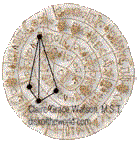
![]() This cone, or obelisk, revealed by connecting with lines the four Hand/Glove pictographs, really seems to stand straight up off the Phaistos Disk. To these ancient Minoan astronomers and geometers, containment of geometrical arrangements was religion because it shows intelligent design of the universe that humans can grasp, thanks to three absolutes anyone can recognize - movement, the stars, and geometry. From the point of view of the mind that created the Phaistos Disk, the idea of God the Geometer works very well with God the Potter because God, having scientifically designed the universe with geometry, now needs the spinning movement of the pottery wheel to materially create it.
This cone, or obelisk, revealed by connecting with lines the four Hand/Glove pictographs, really seems to stand straight up off the Phaistos Disk. To these ancient Minoan astronomers and geometers, containment of geometrical arrangements was religion because it shows intelligent design of the universe that humans can grasp, thanks to three absolutes anyone can recognize - movement, the stars, and geometry. From the point of view of the mind that created the Phaistos Disk, the idea of God the Geometer works very well with God the Potter because God, having scientifically designed the universe with geometry, now needs the spinning movement of the pottery wheel to materially create it.
Other concepts fit in well with this religious philosophy and help explain reality, such as the idea that everything that exists comes out of this great geometer's imagination and intelligent use of geometry. Also built into this system is the idea of illusion as a meaningful part of reality. Miraculously, we live happily inside an illusion of reality, in the space geometry creates, and we know from Hinduism, a contemporary with the Minoan civilization, that there is the possibility that everything in our world is illusion or reflection or projection. Look at the cone again and imagine we live in something like this, a plane of reality that is both real and illusion. (left)
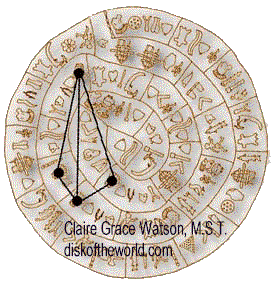
Emanationism, which is the closest thing I can think of to Planeism, is an ancient religious philosophy that underlies nearly all historical religions and proposes the existence of God in the higher realms of light as emanating the world, which flowed out of God. Emanationism began (historically) in archaic Egypt as a parallel tradition with Sumer in Mesopotamia (ca. 3000 BCE), perhaps earlier. Both were derived from an even more archaic source involving Dualism.
In Egypt, and particularly in Sumer, Emanationism was expressed as the Three Primordial Principles, the beginning of a number philosophy that became widespread later on throughout Egypt, Mesopotamia, Persia and most of the Mediterranean world. The Three Primordial Principles were thought to be the cause of the creation of the universe that came into being as a result of the interplay between the two opposing principles and the intermediate principle of unity. The two opposing principles, found in philosophy as Dualism and as the Doctrine of Two Contraries (Yin-Yang), usually were expressed in antiquity as male and female and as light and dark. The ancients deified the number three, the original Holy Trinity expressed in geometry as the triangle because it all made perfect sense.
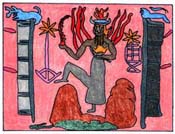
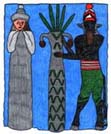

Emanationism is a stepped-down version of Planeism in that Emantionism does not include complex geometry as part of its belief structure but is built mainly on numbers 1, 2, and 3. Planeism advances the higher numbers and their geometries to study the phenomenal universe through geometry and view God as a geometer or as the Absolute who is differentiating Self into a phenomenal universe through geometry and then bringing it physical via clay and movement of a potter's wheel.
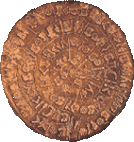
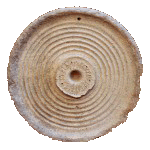
This would only make perfect sense to a Minoan because one glance at the pottery of that age shows the geometric orientation of it as well the incredible creativity on the part of the artists. They were well versed in geometry and certainly inspired. In fact, the massive amount of geometric pottery such as has been excavated seems to indicate that Planeism, or whatever it was called, was a widely known religious philosophy and not just esoteric knowledge held by a priest cast. This is not just limited to their pottery but nearly every aspect of their world.
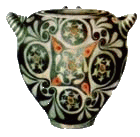 This vase, for example, is something like the equivalent of a Sistine Chapel if we take into consideration that geometric forms were considered to be divine. But the Minoans spread their ideas of divinity all throughout their art of geometric orientation, whereas later on in the world we asserted the human form as divine. Our histocial religious beliefs about God have to do with humans being made in God's image, inspiring the art of Michelangelo and so many other artists, but in the ancient world it was no such thing because the basis of God was geometry, perhaps inspiring the construction of the Great Pyramid as a divine representation. To our way of modern thinking, unfortunately, Minoan art is beyond their capabilities, or what we believe their capabilities to be, and this because all of it is based on an artistic familiarity with geometry that relatively we have not achieved, in my opinion. Were the pyramids built as temples to God the Geometer? Are they the equivalent of our grandest cathedrals all rolled into one?
This vase, for example, is something like the equivalent of a Sistine Chapel if we take into consideration that geometric forms were considered to be divine. But the Minoans spread their ideas of divinity all throughout their art of geometric orientation, whereas later on in the world we asserted the human form as divine. Our histocial religious beliefs about God have to do with humans being made in God's image, inspiring the art of Michelangelo and so many other artists, but in the ancient world it was no such thing because the basis of God was geometry, perhaps inspiring the construction of the Great Pyramid as a divine representation. To our way of modern thinking, unfortunately, Minoan art is beyond their capabilities, or what we believe their capabilities to be, and this because all of it is based on an artistic familiarity with geometry that relatively we have not achieved, in my opinion. Were the pyramids built as temples to God the Geometer? Are they the equivalent of our grandest cathedrals all rolled into one?
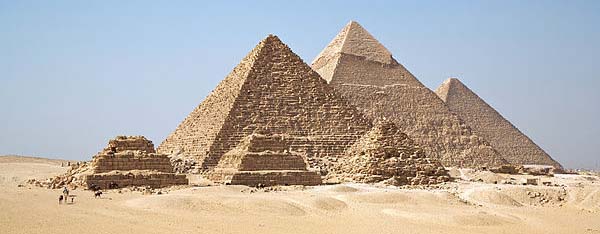
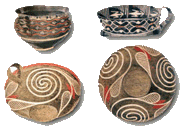 Emanationism in its fullest development is much later in history than Planeism of Minoan Crete, but in its beginning development in Mesopotamia it may have been a less developed contemporary of Planeism. It could be that Planeism lost the popularity race with Emanationism because the scientific aspects of it could not compete with Emanationism's reliance on simple faith: i.e., we have faith that God created the world but we also know we cannot understand how God did it. That lets us off the hook in terms of having to think a lot. Planeism does not give up on our ability to understand how the world is created. In this geometry theology, ultimate reality is numerical, number is the key to the universe, and triangles are the fundamental building blocks of the cosmos.
Emanationism in its fullest development is much later in history than Planeism of Minoan Crete, but in its beginning development in Mesopotamia it may have been a less developed contemporary of Planeism. It could be that Planeism lost the popularity race with Emanationism because the scientific aspects of it could not compete with Emanationism's reliance on simple faith: i.e., we have faith that God created the world but we also know we cannot understand how God did it. That lets us off the hook in terms of having to think a lot. Planeism does not give up on our ability to understand how the world is created. In this geometry theology, ultimate reality is numerical, number is the key to the universe, and triangles are the fundamental building blocks of the cosmos.
Emanationism may be humanity's oldest and most widespread religious philosophy with the exception of Bull Worship. Both Emanationism and Planeism approach spiritual knowledge from a scientific philosophic orientation, but Planeism more than Emanationism offers a description of the universe's rational order that is based upon a comprehensible intellectual structure because of geometry, motion and the stars. Still, it was Emanationism and not Planeism that bequeathed us the Three Primordial Principles which Planeism may have been originally built upon.
Emanationism proposed this physical world as existing as a reflection of the higher realms of God in an as above, so below reality, whereas with Planeism we are approaching it from an "as below, so above" point of view. We are looking at it from the bottom up rather than the top down, and this also acknowledges our ability to understand it from our point of view. Emanationism offers the theory of Mind and Idea, the idea that the Creator existed alone in the universe and has the idea to create a world. But the created world is illusory, a reflection of the higher realms of God. The Phaistos Disk shows, way ahead of its time as regards this Mind and Idea religious philosophy, how the illusory world can have reality, so that the solid humans created out of clay by Khnum on the potter's wheel can exist creatively in a virtual world and comfortable home of plane geometry comprised of geometry, stars, spin, and illusion.
![]()
 In this example of invisible planes of reality/geometry, I connect both sides of the Phaistos Disk together at the matching line segments to produce a vertical figure 8 symbol of infinity and a Minoan wave spiral comprised of two spheres, each containing two spirals. Populating these spirals are a total of 240 pictographs. The Isis/Rhea goddess pictograph (left) appears four times over both sides of the disk (the four dots). In the ancient Egyptian world, Isis is the goddess of nature who gives us all things in the physical world. By connecting the four Isis pictographs together with lines, I can see how She does it. From out of the Great Geometer's groundplan and using three or four triangles, depending how you view the dimensional plane, Isis/Rhea builds for us a plane of existence, something that is there and not there, a plane geometry realm that rises vertically above the spirals to exist-not. (Stare at it and watch it shift perspective.)
In this example of invisible planes of reality/geometry, I connect both sides of the Phaistos Disk together at the matching line segments to produce a vertical figure 8 symbol of infinity and a Minoan wave spiral comprised of two spheres, each containing two spirals. Populating these spirals are a total of 240 pictographs. The Isis/Rhea goddess pictograph (left) appears four times over both sides of the disk (the four dots). In the ancient Egyptian world, Isis is the goddess of nature who gives us all things in the physical world. By connecting the four Isis pictographs together with lines, I can see how She does it. From out of the Great Geometer's groundplan and using three or four triangles, depending how you view the dimensional plane, Isis/Rhea builds for us a plane of existence, something that is there and not there, a plane geometry realm that rises vertically above the spirals to exist-not. (Stare at it and watch it shift perspective.)
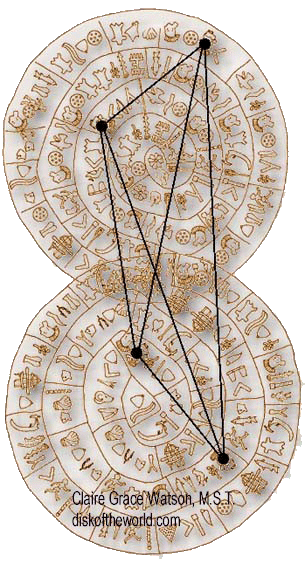
The intersecting point, the center of the X as in X marks the spot, is located at the exact position where the two sides of the disk intersect at the connecting line segments. In this geometry representation, Isis is creating a realm for us out of two realms represented by the disks, the realm below and the realm above - the world of earth and the world sky. Although these realms are relative in position - one is "above" and the other is "below," both are required to create the third and virtual realm, fulfilling the ancient formula for reality involving the holy trinity of two tangibles and an intangible, in Christianity "Father, Son, and Holy Spirit." The "above" and the "below" are tangible spirals from out of which arises the intangible - but nevertheless real - geometric structure.
In this ancient version of creation in which the tools of geometry are used, God the Geometer designed a universe out of geometry. In Emanationism, the philosophy is that God had an idea, and the idea is itself the universe. Also in Emanationism the universe is set in motion by God thinking and thus is a moving reflection of the still Mind of God from which it emanated. This is a concept in Planeism as well, as demonstrated by the Phaistos Disk, but more in terms of intersecting planes and spin.



![]() On the Phaistos Disk are two Thysri/Diameter pictographs (left) on side two. When connected with a line they create diameter (above). From the physical spin of the diameter comes another diameter, a vertical and illusory one. (My exact tracings of the disk, color inverted, animated gif.)
On the Phaistos Disk are two Thysri/Diameter pictographs (left) on side two. When connected with a line they create diameter (above). From the physical spin of the diameter comes another diameter, a vertical and illusory one. (My exact tracings of the disk, color inverted, animated gif.)
 The diameter animation creates an equal-arms cross, in which length and width are the same, so that, with the addition of spin, these original two principles, Mind and Idea, produce a third principle -- That Which Contains/That Which is Contained, the whole concept demonstrated by this Minoan symbol of the Goddess of the Double Axes (Axis?) that seems to imply movement and spin. (right)
The diameter animation creates an equal-arms cross, in which length and width are the same, so that, with the addition of spin, these original two principles, Mind and Idea, produce a third principle -- That Which Contains/That Which is Contained, the whole concept demonstrated by this Minoan symbol of the Goddess of the Double Axes (Axis?) that seems to imply movement and spin. (right)
When we lost the religious philosophy of Planeism, or whatever it was called during Minoan Crete, we gained Mysticism. That does not represent a complete disaster but it certainly is a loss because in Mysticism we have another form of hysterical, I mean historical, religion, in that we "do not understand things except to know we can't understand things but worship them anyway, mostly because they surpass our understanding." That verges on superstition. Planeism explained to us long ago the universe in terms simple and understandable, but because it included mathematics, geometry and astronomy and required some knowledge of those subjects we may have no choice but to conclude that, as time passed, we lost some intellectual capacity to understand it. At the very least, we got distracted by other things that afforded more gratification with less mental effort.
Greece had almost forgotten, though the poet [Homer] had not, that the island [Crete] whose wealth seemed to him even then so great had once been wealthier still; that it had held sway with a powerful fleet over most of the Aegean and part of mainland Greece; and that it had developed, a thousand years before the siege of Troy, one of the most artistic civilizations in history. Probably it was this Aegean culture—as ancient to him as he is to us— that Homer recalled when he spoke of a Golden Age in which men had been more civilized, and life more refined, than in his own disordered time. (Will Durant, Life of Greece)
Copyright Notice - Disk of the World - Text and images copyrighted March 21, 1993-2025, Claire Grace Watson, B.A., M.S.T., U.S. Copyright and under the Digital Millennium Copyright Act of 1998, All rights reserved. No part of this web page may be reproduced or transmitted in any form or by any means without written permission from the author, except for the inclusion of brief quotations in a review.